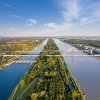- Joined
- Jan 21, 2018
- Messages
- 112
- Reactions
- 23
- Age
- 74
Which is better without post editing?
Which is best with post editing ?

no the aperture wont change, its the shutter speed that changes in aeb, i shoot aeb all the time on my mav 1 and my cameras and this is how it worksfor AEB if you take say 5 photos would you keep the ISO and speed fixed and change only the aperture from say f 2,8 all the way up to say f 5,6 ?
no the aperture wont change, its the shutter speed that changes in aeb, i shoot aeb all the time on my mav 1 and my cameras and this is how it works
Well obviously since the Mavic Pro has a fixed aperture. The 2 Pro has an adjustable one so there it may or may not vary, but you can't say without experience.no the aperture wont change, its the shutter speed that changes in aeb, i shoot aeb all the time on my mav 1
yes and to adjust the exposre u adjust the shutter speed, dji has aeb in the mav1 and all thier other aircraft with no aperture, this is how it works, if u adjusted the aperture u would get different focus points as well and thats not how aeb works, if it took a photo at 2.8 to f5.6 there would be different focus points and that would be focus stacking, which my camera does but drones dont, its for macro photograpghylooking at various forums i see that with AEB only the exposure varies, speed and iso almost always stays the same.

Well obviously since the Mavic Pro has a fixed aperture. The 2 Pro has an adjustable one so there it may or may not vary, but you can't say without experience.
Normally it shouldn't, but we all know DJI...
I always use the “graduated filter” in Lightroom to fix my sky’s. Do all your processing/editing to have your foreground as you want it. At this stage your sky will prob be blown out. Just pull down the graduated filter and now bring it back to how you want it to look.for AEB if you take say 5 photos would you keep the ISO and speed fixed and change only the aperture from say f 2,8 all the way up to say f 5,6 ?
I have some trouble taking photos of a building which is really dark with a sky which is really bright because of shadows from mountain and trees behind..
i took many raw photos but whatever post processing i used with adobe Lr it was terrible, have to try AEB.
have attached a sample photo of the subject .. any suggestions on iso, speed and aperture range settings?View attachment 47990

We use essential cookies to make this site work, and optional cookies to enhance your experience.

